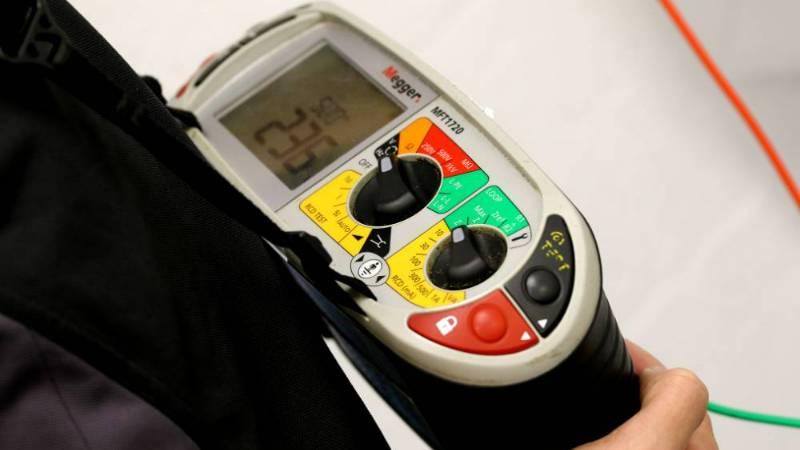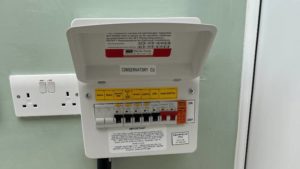What is fixed wire testing?
Fixed Wire Testing, also known as an Electrical Installation Condition Report (EICR), is a thorough inspection and testing of the electrical systems within a building. This process involves examining the electrical installations and circuits to ensure they are safe and comply with current safety standards, specifically the British Standard BS 7671: 2018. The test includes a visual inspection, as well as physical testing, to check all low-voltage electrical systems, including main LV panels, distribution boards, consumer units, lights, sockets, cables and accessories for any overloads, defects, or hazards.
Is fixed wire testing a legal requirement?
Fixed wire testing isn’t technically a legal requirement on it’s own but it falls under the remit of the Electricity at Work Regulations 1989, which stipulates that all electrical systems must be maintained to prevent danger. Additionally, the Health and Safety at Work Act 1974 imposes a duty on employers to ensure the health, safety, and welfare of their employees. This includes maintaining electrical installations. Fixed wire testing is a key method to comply with these regulations, ensuring that the electrical installations in workplaces are safe and do not pose a risk to employees or visitors.
How often should fixed wire testing be carried out?
The frequency of fixed wire testing should be determined based on the BS 7671 IET Wiring Regulations 18th Edition. This standard provides guidelines on how often electrical installations should be inspected and tested. The recommended intervals can vary depending on the type of installation, its use, and the environment in which it is situated. Generally, fixed wire testing is required every 5 years for commercial premises, 3 years for industrial premises, 10 years for domestic and residential properties, and 5 years for shops and offices. Please see our brief frequency guide below in line with the recommendations from IET Guidance Note 3 which incorporates BS 7671: 2018 and covers the most common types of electrical installations.
| Type Of Installation | Fixed Wire Testing Frequency |
| Domestic Accommodation: general | 10 years or change of occupancy |
| Domestic Accommodation: rented houses and flats | 5 years |
| Commercial | 5 years |
| Education Establishments (Schools, Universities etc) | 5 years |
| Industrial | 3 years |
| Offices | 5 years |
| Shops | 5 years |
| Cinemas | 1-3 years |
| Churches | 5 years |
| Leisure Complexes (excluding swimming pools) | 3 years |
| Restaurants. Hotels and Short-Term Lets | 5 years |
| Theatres | 3 years |
How long does fixed wire testing take?
The duration of fixed wire testing can vary significantly depending on several factors. These include the size and complexity of the electrical installation, the number of circuits, and the specific condition of the premises. For a small property or installation, testing might take around a day, while larger commercial or industrial facilities could require several days or even weeks. Each circuit is tested individually, and the process involves both visual inspection and electrical testing.
Are Fixed Wire Testing and PAT Testing the same?
Fixed Wire Testing and PAT Testing (Portable Appliance Testing) are not the same.
Fixed Wire Testing, also known as an Electrical Installation Condition Report (EICR), is the testing of the permanent electrical systems within a building. This includes the wiring, sockets, and light fittings and is concerned with the overall electrical safety of the property.
PAT Testing, on the other hand, involves inspecting and testing portable electrical appliances to ensure they are safe to use. This includes items like computers, kettles, and office equipment that can be unplugged and moved.
Both are important for safety and compliance but focus on different aspects of electrical safety.
See our guide to PAT testing here.
How much does fixed wire testing cost?
The cost of fixed wire testing can vary widely depending on several factors, such as the size and complexity of the property, the number of electrical circuits, the age of the installation, and the geographical location of the property. For smaller properties or businesses, the cost might be relatively lower, while larger commercial or industrial sites can expect higher costs due to the scale and complexity of the testing required.
Typically, a Fixed Wire Test (EICR) for a domestic property is around £150 – £350 whereas a commercial property can be substantially higher due to the number of circuits.
For an accurate cost for your fixed wire testing, get your free quote here!

Get in touch with the Martin Cook Electrical Services team today and request your free, no-obligation quotation. Have any questions? We’re here to help with any of your queries.
Who can carry out fixed wire testing?
Fixed wire testing should be carried out by a qualified and competent electrician or electrical contractor. Ideally, this professional should be accredited by a recognized industry body such as the National Inspection Council for Electrical Installation Contracting (NICEIC) in the UK. They should have the necessary qualifications, such as a City & Guilds certificate in inspection and testing of electrical equipment and be up to date with the latest wiring regulations (BS 7671). It’s important to ensure that the individual or company has the expertise and experience to conduct thorough and compliant electrical testing. Also, the company or individual needs to be insured correctly to carry out fixed wire testing (EICRs).
What do the EICR codes mean?
The codes in an Electrical Installation Condition Report (EICR) indicate the severity and urgency of any defects found during fixed wire testing. They are:
Code C1: Indicates an immediate danger. Urgent remedial action is required to ensure safety.
Code C2: Suggests potential danger. Prompt remedial action is needed.
Code C3: Recommends improvements. While it points out non-compliance with current standards, it doesn’t indicate immediate or potential danger.
Code FI: Stands for ‘Further Investigation’. This is used when an issue needs a more detailed examination to assess the level of risk.
These codes help in prioritizing the corrective actions needed to ensure electrical safety.
More information on coding can be found within the Best Practice Guide 4 by Electrical Safety First here.
How do you get a satisfactory Electrical Installation Condition Report (EICR)?
To obtain a satisfactory Electrical Installation Condition Report (EICR), all defects identified with C2 (Potential Danger) and FI (Further Investigation Required) codes must be rectified.
Once all C2 and FI issues are resolved, along with any other necessary repairs or improvements, the electrical installation can be deemed safe, leading to a satisfactory EICR.

Where We Carry Out Fixed Wire Testing
At Martin Cook Electrical, we provide fixed wire testing services across London, Milton Keynes, Oxford, Leighton Buzzard, and many other towns and cities.
Bletchley, Aylesbury, Luton, Dunstable, Bedford, Buckingham, Northampton, Woburn, Towcester, Flitwick, Newport Pagnell, Stony Stratford, Wellingborough, Cranfield, Wolverton, Hemel Hempstead, Tring, Harpenden, Hitchin, Chesham, Amersham, Stevenage, Watford, Banbury, Bicester, Didcot, Harrow, Kettering, Leighton Buzzard, Rickmansworth, St Albans, Aldbury, Potters Bar, Redbourn, Gerrards Cross, Princes Risborough, Maidenhead, High Wycombe, Beaconsfield, Biggleswade, Houghton Regis, Hertford, Ware, Royston, Leagrave, Sandy, Winslow.
We ensure compliance with electrical safety standards across this entire region. Contact us today to book your fixed wire testing!


